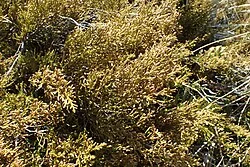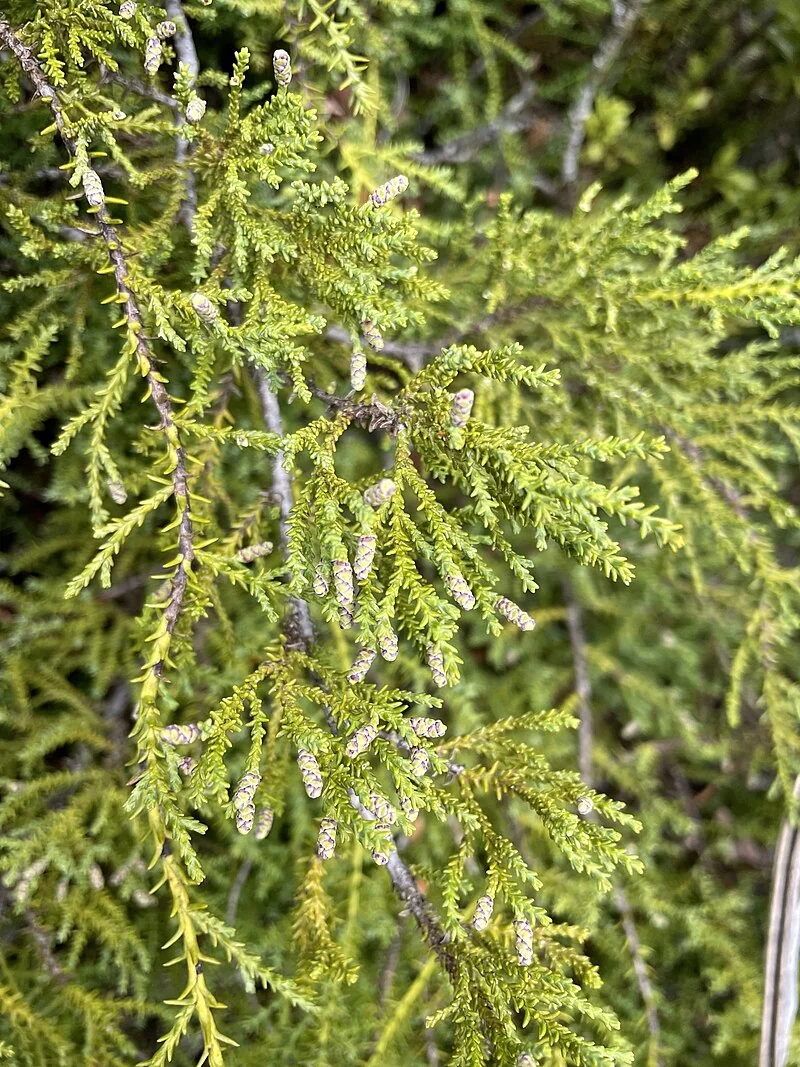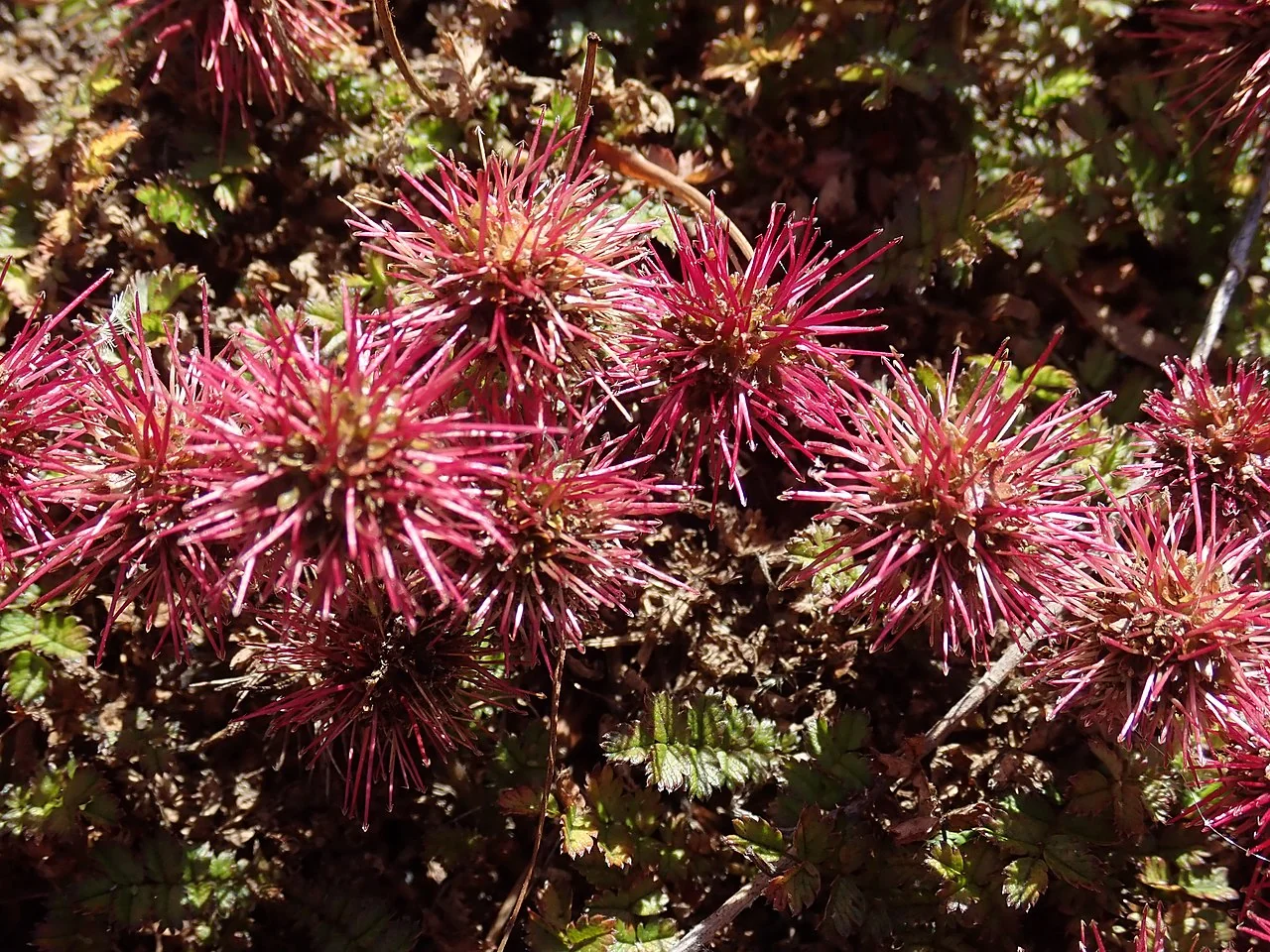
Pygmy Pine
Lepidothamnus laxifolius
Pygmy Pine ( Lepidothamnus laxifolius ) holds the remarkable distinction of being the world's smallest conifer , creating an extraordinary example of evolutionary adaptation that allows this diminutive native to thrive in New Zealand's harshest alpine and subalpine environments. This unique prostrate shrub rarely exceeds 10-30cm in height, instead spreading horizontally across the landscape in dense, carpet-like mats that can extend over a meter wide, demonstrating how extreme environmental conditions can shape plant form in the most unexpected ways. The plant's tiny, scale-like leaves are tightly pressed against slender stems, creating a heath-like appearance that helps it withstand the fierce winds, temperature extremes, and intense UV radiation characteristic of New Zealand's high-altitude regions. Found naturally in boggy, exposed sites from 600-1800 meters elevation, Pygmy Pine has evolved remarkable tolerance for nutrient-poor, acidic soils and waterlogged conditions that would challenge most other woody plants. Its incredibly slow growth rate - sometimes taking decades to spread just a few centimeters - reflects the harsh realities of alpine life, where every growing season is brief and resources are scarce. Despite its humble size, this ancient conifer plays important ecological roles in alpine ecosystems, helping to stabilize soil, provide microhabitat for invertebrates, and contribute to the unique botanical tapestry that makes New Zealand's mountain environments so distinctive. The species serves as a living testament to the power of evolutionary adaptation, showing how plants can successfully colonize even the most challenging environments through specialized form and function.

Pygmy Pine ( Lepidothamnus laxifolius ) is a remarkable native New Zealand conifer, holding the distinction of being the world's smallest conifer. This diminutive, sprawling shrub is celebrated for its tiny, scale-like leaves and its ability to thrive in harsh, exposed subalpine and alpine environments. Endemic to New Zealand, it is typically found in boggy areas, open scrublands, and rocky outcrops, often forming dense mats. Its unique size and extreme hardiness make it a fascinating subject for alpine gardens, rockeries, or as a groundcover in challenging conditions, showcasing the ancient lineage of New Zealand's conifers in a miniature form.
Quick Facts
Conifer Summary
| Scientific Name | Lepidothamnus Laxifolius |
|---|---|
| Common Name | Pygmy Pine |
| Family | Podocarpaceae |
| Height | Prostrate, up to 15 cm tall |
| Spread | Sprawling, up to 1 m wide |
| Light | Full sun to partial shade |
| Soil | Moist, well-drained, acidic soils |
| Water Needs | Moderate |
| Frost Tolerance | High |
| Salt Tolerance | Low to Moderate |
| Growth Rate | Very Slow |
| Lifespan | Long |
Climate Best Suited to
Regional Suitability
Pygmy Pine ( Lepidothamnus laxifolius ) is native to the subalpine and alpine zones of New Zealand, thriving in cool, moist, and exposed environments. It is highly adapted to harsh conditions, including strong winds, intense UV radiation, and prolonged periods of frost and snow. While it prefers cooler climates, it can be cultivated in lowland areas provided it has excellent drainage, consistent moisture, and protection from extreme summer heat. Its natural habitat includes boggy areas, rocky outcrops, and open tussocklands at higher altitudes.
| Whangārei | Ideal |
| Auckland | Ideal |
| Hamilton | Suitable |
| Rotorua | Suitable |
| Tauranga | Ideal |
| Gisborne | Ideal |
| New Plymouth | Ideal |
| Whanganui | Ideal |
| Palmerston North | Suitable |
| Napier | Ideal |
| Wellington | Ideal |
| Nelson | Ideal |
| Christchurch | Suitable |
| Dunedin | Suitable |
| Invercargill | Suitable |
| City | Climate Suitability |
|---|
Natural Habitat
Alpine Distribution
Understand the natural habitat of Pygmy Pine ( Lepidothamnus laxifolius ), which is found in subalpine and alpine zones across New Zealand. This section details its geographical distribution, preferred environmental conditions, and the types of ecosystems where it naturally occurs.
- Widespread in subalpine and alpine regions of the North and South Islands.
- Found in boggy areas, rocky outcrops, and open tussocklands at higher altitudes.
- Prefers moist, well-drained, acidic sites.
- Thrives in full sun to partial shade in cooler climates.
Its broad habitat range highlights its adaptability and resilience, making it a fascinating subject for ecological study.
Plant Conservation
Lepidothamnus laxifolius , commonly known as pygmy pine or mountain rimu, is a conifer species endemic to New Zealand. It is found in the North Island, South Island, and Stewart Island, typically inhabiting high-altitude bog communities and scrub, though it can also be found in lowland areas on Stewart Island. Regarding its conservation, the species is currently classified as "Least Concern" by the IUCN (International Union for Conservation of Nature) (IUCN 3.1). Similarly, the New Zealand Threat Classification System (NZTCS) assessed its status as "Not Threatened" in 2023. This indicates that, at present, Lepidothamnus laxifolius is not considered to be at significant risk of extinction, and there are no widespread conservation concerns or specific threats highlighted for the species.
Growing Requirements
Soil Requirements
Pygmy Pine thrives in moist, very well-drained, acidic soils, mimicking its natural alpine and boggy habitat. It tolerates a range of soil types from gritty to peaty, but excellent drainage is crucial to prevent root rot, especially in wetter climates. Incorporating coarse sand or grit can improve soil structure. Avoid heavy clay soils or areas prone to waterlogging.
- Prefers moist, very well-drained, acidic soils.
- Tolerates gritty to peaty soil types.
- Excellent drainage is essential.
- Avoid heavy clay or waterlogged conditions.
Light Requirements
Pygmy Pine performs best in full sun to partial shade. In its natural alpine environment, it receives intense sunlight. In garden settings, full sun will encourage a denser, more compact habit. Partial shade is tolerated, especially in warmer lowland areas, but may result in leggier growth.
- Full sun to partial shade.
- Denser growth in full sun.
- Adaptable to various light conditions.
Water Requirements
Pygmy Pine requires moderate watering, especially during dry periods and its establishment phase. While it can tolerate some drought, consistent moisture is beneficial for optimal growth. Ensure the soil is consistently moist but never waterlogged, as this can lead to root rot.
- Moderate watering needs.
- Tolerates some drought once established.
- Avoid waterlogging.
Planting Guide
Best Time to Plant
The best time to plant Pygmy Pine is during autumn or spring, when temperatures are mild and rainfall is more consistent. This allows the plant to establish its root system before the extremes of summer heat or winter cold.
Choosing a Location
Select a site with full sun to partial shade and moist, very well-drained, acidic soil. Pygmy Pine is ideal for rock gardens, alpine troughs, crevice gardens, or as a tough groundcover in exposed, cooler locations. Ensure it has good air circulation.
Planting Steps
- Dig a hole twice the width of the root ball and the same depth.
- Gently remove the plant from its container, being careful not to disturb the roots.
- Place the plant in the hole, ensuring the top of the root ball is level with the surrounding soil.
- Backfill with amended soil (e.g., gritty mix), firming gently around the base of the plant.
- Water thoroughly immediately after planting to settle the soil.
- Apply a light layer of gravel or grit mulch to help retain moisture and suppress weeds, mimicking its natural alpine environment.
Initial Care
Water regularly during the first 6-12 months to help establish a strong root system. Once established, Pygmy Pine is reasonably low maintenance and requires less frequent watering. Protect young plants from extreme conditions if necessary.
Ecological Role
Alpine Ecosystem Importance
The ecological importance of Pygmy Pine ( Lepidothamnus laxifolius ) within its native New Zealand alpine ecosystems is significant. Its dense, mat-forming growth helps to stabilize fragile soils on rocky slopes, preventing erosion and creating microclimates for other alpine species.
- Helps stabilize fragile alpine soils, preventing erosion.
- Seeds may provide a food source for native birds and lizards in high-country environments.
- Provides shelter for small invertebrates and contributes to alpine biodiversity.
As an endemic species, it is an integral part of the unique biodiversity that has evolved in New Zealand, supporting the delicate balance of its natural habitats.
Uses and Significance
Garden Uses
- Excellent for rock gardens, alpine troughs, and crevice gardens.
- Suitable as a tough, low-maintenance groundcover.
- Provides year-round interest with evergreen, scale-like foliage.
- Ideal for cooler climates and exposed sites.
Heritage Value
As an endemic New Zealand alpine plant and the world's smallest conifer, Pygmy Pine is a testament to the unique evolutionary history of the country's flora. Its resilience and beauty in harsh environments contribute to the overall cultural and ecological tapestry of Aotearoa, representing the resilience and beauty of alpine ecosystems.
- Part of New Zealand's endemic alpine flora.
- World's smallest conifer.
- Symbolizes resilience and adaptation to extreme conditions.
- Contributes to the unique character of high-country landscapes.
Ecologically, Pygmy Pine plays an important role in alpine ecosystems. Its dense, mat-forming growth helps to stabilize soil on rocky slopes, preventing erosion. Its seeds may provide a food source for native birds and lizards, contributing to the local food web and aiding in seed dispersal in challenging environments.
Cultural Significance
Traditional Uses and Values
Lepidothamnus laxifolius , commonly known as pygmy pine or mountain rimu, is a conifer endemic to New Zealand. While conifers in New Zealand hold historical significance in both native Māori and European cultures, specific cultural uses or traditional significance directly attributed to Lepidothamnus laxifolius are not extensively documented.
The plant is primarily noted for its ecological characteristics and modern uses, such as being one of the smallest conifers in the world and its role in alpine ecosystems.
Landscaping Applications
Garden Design Uses
Pygmy Pine ( Lepidothamnus laxifolius ) is an excellent choice for landscaping in alpine, rock, and native gardens, particularly in cooler climates. Its prostrate habit and unique foliage make it a valuable asset for creating resilient and beautiful landscapes.
- Ideal for rock gardens, alpine troughs, and crevice gardens.
- Excellent as a tough, low-maintenance groundcover for exposed sites.
- Provides year-round interest with evergreen, scale-like leaves.
- Suitable for cooler climates and high-altitude environments.
Its ability to thrive in challenging conditions and its aesthetic appeal make it a popular choice for creating unique and ecologically appropriate native landscapes.
Seasonal Care Calendar
Spring
New growth emerges, often with a golden tinge, and the plant begins its active growth phase. This is an ideal time for planting new Pygmy Pine specimens. Ensure consistent moisture for young plants and protect them from strong winds if necessary. A light feed with a balanced slow-release fertilizer can encourage vigorous growth.
- Ideal time for planting.
- Ensure consistent moisture for new plants.
- Light fertilization if needed.
Summer
Pygmy Pine is actively growing during summer. Consistent watering is important, especially during dry spells, to prevent stress. Monitor for pests and diseases, though it is generally quite resilient.
- Active growth.
- Consistent watering is essential.
- Monitor for pests and diseases.
Autumn
Growth slows as temperatures cool. This is another good time for planting, allowing roots to establish before winter. Minimal care is required for established plants, but ensure they remain adequately hydrated.
- Good time for planting.
- Minimal care for established plants.
- Ensure adequate hydration.
Winter
Pygmy Pine is evergreen and provides year-round interest. It is highly frost-tolerant and requires minimal care during this period. Ensure good drainage to prevent root issues in wet conditions, especially if snow cover is prolonged.
- Evergreen, provides year-round interest.
- Highly frost-tolerant.
- Ensure good drainage.
When to Prune and How Much
Minimal Pruning
Pygmy Pine generally requires minimal pruning. The primary reason for pruning is to remove dead or damaged stems, or to tidy up the plant's appearance. Its very slow growth rate means it rarely needs extensive pruning.
- Remove dead or damaged stems as needed.
- Light trimming to maintain shape and encourage density.
- Best done in late winter or early spring before new growth.
- Use clean, sharp tools.
Avoid heavy pruning, as this can stress the plant. Its natural prostrate habit is part of its charm, so allow it to spread naturally.
How to Grow Pygmy Pine
Pygmy Pine, the world's smallest conifer, is a unique and fascinating native New Zealand plant. This diminutive, sprawling shrub is celebrated for its tiny, scale-like leaves and its ability to thrive in harsh, exposed subalpine and alpine environments. Endemic to New Zealand, it is typically found in boggy areas, open scrublands, and rocky outcrops, often forming dense mats. Its unique size and extreme hardiness make it a fascinating subject for alpine gardens, rockeries, or as a groundcover in challenging conditions, showcasing the ancient lineage of New Zealand's conifers in a miniature form. Understanding its propagation methods is key to successfully growing this specialized species.
From Seed
Propagating Pygmy Pine from fresh seed is a viable method, though germination can be slow and may require stratification. Collect ripe seeds in late autumn or early winter. Clean the seeds thoroughly to remove any fleshy pulp. Sow the seeds in a tray filled with a well-draining, acidic seed-raising mix, lightly covering them. The seeds typically require a period of cold stratification (e.g., refrigerate for 2-3 months) to break dormancy. Maintain consistent moisture in the seed tray and keep it in a cool, sheltered location. Germination can take several weeks to months after stratification. Once seedlings have developed a few true leaves, they can be potted into individual containers and grown in a sheltered environment before planting out.
From Cuttings
Semi-hardwood cuttings are a reliable method for propagating Pygmy Pine, ensuring that new plants retain the exact characteristics of the parent. Take 5-10 cm cuttings from healthy, non-flowering stems in late summer or early autumn. Remove the lower leaves and dip the cut end in a rooting hormone. Insert the cuttings into a well-draining propagation mix (e.g., sand and perlite). Keep the cuttings in a cool, humid environment, out of direct sunlight, perhaps under a plastic dome or in a propagator. Rooting typically occurs within 8-12 weeks. Once rooted, the new plants can be potted on and grown in a sheltered environment until they are ready for planting.
Pests and Diseases
Pygmy Pine is a remarkably hardy plant and generally resistant to most pests and diseases. Its adaptation to diverse upland environments means it has few significant natural enemies.
Common Pests
- Generally pest-free.
- Occasionally, aphids or scale insects may appear on new growth, but rarely cause significant damage.
Common Diseases
- Highly resistant to diseases.
- Root rot can occur in poorly drained, waterlogged soils, especially if snow cover is prolonged.
- Leaf spot diseases are rare but can occur in very humid conditions.
Good garden hygiene, proper watering, and excellent drainage are key to preventing most pest and disease issues. Healthy, well-sited plants are rarely affected by significant problems.
Bonus Tip
The World's Smallest Conifer
The Pygmy Pine holds the remarkable distinction of being the world's smallest conifer. This tiny plant rarely grows taller than 30 cm, instead spreading horizontally across the landscape in dense, carpet-like mats. This extreme dwarfism is an adaptation to the harsh alpine and subalpine environments where it thrives, allowing it to withstand strong winds, temperature extremes, and intense UV radiation.







